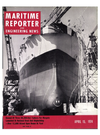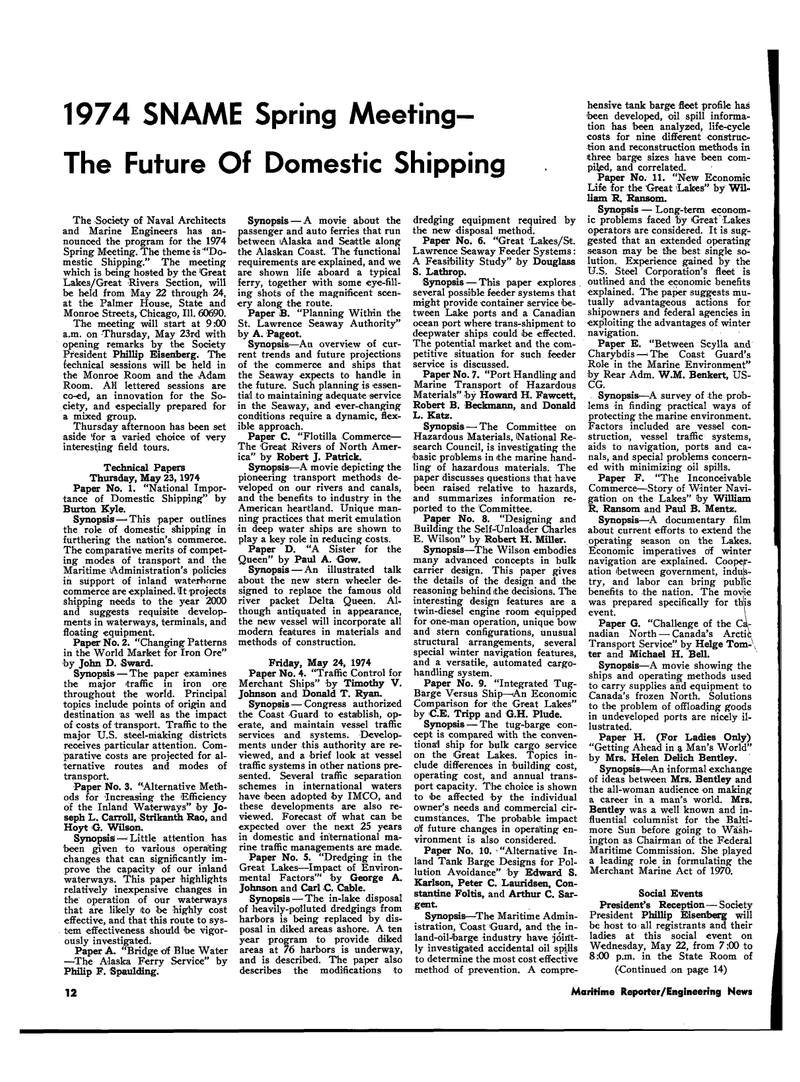
Page 10: of Maritime Reporter Magazine (April 15, 1974)
Read this page in Pdf, Flash or Html5 edition of April 15, 1974 Maritime Reporter Magazine
1974 SNAME Spring Meeting-
The Future Of Domestic Shipping
The Society of Naval Architects and Marine Engineers has an- nounced the program for the 1974
Spring Meeting. The theme is "Do- mestic Shipping." The meeting which is being hosted by the 'Great
Lakes/Great Rivers Section, will be held from May 22 through 24, at the Palmer House, State and
Monroe Streets, Chicago, 111. 60690.
The meeting will start at 9:00 a.m. on Thursday, May 23rd with opening remarks by the Society
President Phillip Eisenberg. The technical sessions will be held in the Monroe Room and the Adam
Room. All lettered sessions are co-ed, an innovation for the So- ciety, and especially prepared for a mixed group.
Thursday afternoon has been set aside 'for a varied choice of very interesting field tours.
Technical Papers
Thursday, May 23,1974
Paper No. 1. "National Impor- tance of Domestic Shipping" by
Burton Kyle.
Synopsis—'This paper outlines the role of domestic shipping in furthering the nation's commerce.
The comparative merits of compet- ing modes of transport and the
Maritime Administration's policies in support of inland waterborne commerce are explained. It projects shipping needs to the year 2000 and suggests requisite develop- ments in waterways, terminals, and floating equipment.
Paper No. 2. "Changing Patterns in the World Market for Iron Ore" by John D. Sward.
Synopsis — The paper examines the major traffic in iron ore throughout the world. Principal topics include points of origin and destination as wel'l as the impact of costs of transport. Traffic to the major U.S. steel-making districts receives particular attention. Com- parative costs are projected for al- ternative routes and modes of transport.
Paper No. 3. "Alternative Meth- ods for Increasing the Efficiency of the Inland Waterways" by Jo- seph L. Carroll, Strikanth Rao, and
Hoyt G. Wilson.
SynopsisI—: Little attention has been given to various operating changes that can significantly im- prove the capacity of our inland waterways. This paper highlights relatively inexpensive changes in the operation of our waterways that are likely ito be highly cost effective, and that this route to sys- tem effectiveness should foe vigor- ously investigated.
Paper A. "Bridge of Blue Water —'The Alaska Ferry Service" by
Philip F. Spaulding.
Synopsis — A movie about the passenger and auto ferries that run between Alaska and Seattle along the Alaskan Coast. The functional requirements are explained, and we are shown life aboard a typical ferry, together with some eye-fill- ing shots of the magnificent scen- ery along the route.
Paper B. "Planning Within the
St. Lawrence Seaway Authority" by A. Pageot.
Synopsis—An overview of cur- rent trends and future projections of the commerce and ships that the Seaway expects to handle in the future. Such planning is essen- tial to maintaining adequate service in the Seaway, and ever-changing conditions require a dynamic, flex- ible approach.
Paper C. "Flotilla Commerce—
The Great Rivers of North Amer- ica" by Robert J. Patrick.
Synopsis—A movie depicting the pioneering transport methods de- veloped on our rivers and canals, and the benefits to industry in the
American heartland. Unique man- ning practices that merit emulation in deep water ships are shown to play a key role in reducing costs.
Paper D. "A Sister for the
Queen" by Paul A. Gow.
Synopsis — An illustrated talk about the new stern wheeler de- signed to replace the famous old river packet Delta Queen. Al- though antiquated in appearance, the new vessel will incorporate all modern features in materials and methods of construction.
Friday, May 24, 1974
Paper No. 4. "Traffic Control for
Merchant Ships" by Timothy V.
Johnson and Donald T. Ryan.
Synopsis — Congress authorized the Coast Guard to establish, op- erate, and maintain vessel traffic services and systems. Develop- ments under this authority are re- viewed, and a brief look at vessel traffic systems in other nations pre- sented. Several traffic separation schemes in international waters have been adopted by IMCO, and these developments are also re- viewed. Forecast of what can be expected over the next 25 years in domestic and international ma- rine traffic managements are made.
Paper No. 5. "Dredging in the
Great Lakes—Impact of Environ- mental Factors'" by George A.
Johnson and Carl C. Cable.
Synopsis — The in-lake disposal of heavily-polluted dredgings from harbors is being replaced by dis- posal in diked areas ashore. A ten year program to provide diked areas at 76 harbors is underway, and is described. The paper also describes the modifications to dredging equipment required by the new disposal method.
Paper No. 6. "'Great Lakes/St.
Lawrence Seaway Feeder Systems:
A Feasibility Study" by Douglass
S. Lathrop.
Synopsis — This paper explores several possible feeder systems that might provide container service 'be- tween Lake ports and a Canadian ocean port where trans-shipment to deepwater ships could be effected.
The potential market and the com- petitive situation for such feeder service is discussed.
Paper No. 7. "Port Handling and
Marine Transport of Hazardous
Materials" by Howard H. Fawcett,
Robert B. Beckmann, and Donald
L. Katz.
Synopsis —• The Committee on
Hazardous Materials, National Re- search Council, is investigating the basic problems in (the marine hand- ling of hazardous materials. The paper discusses questions that have been raised relative to hazards, and summarizes information re- ported to the Committee.
Paper No. 8. "Designing and
Building the Self-Unloader Charles
E. Wilson" by Robert H. Miller.
Synopsis—The Wilson embodies many advanced concepts in bulk carrier design. This paper gives the details of the design and the reasoning behind ithe decisions. The interesting design features are a twin-diesel engine room equipped for one-man operation, unique bow and stern configurations, unusual structural arrangements, several special winter navigation features, and a versatile, automated cargo- handling system.
Paper No. 9. "Integrated Tug-
Barge Versus Ship—An Economic
Comparison for the Great Lakes" by >C.E. Tripp and G.H. Plude.
Synopsis — The tug-barge con- cept is compared with the conven- tional ship for bulk cargo service on the Great Lakes. Topics in- clude differences in building cost, operating cost, and annual trans- port capacity. The choice is shown to be affected by the individual owner's needs and commercial cir- cumstances. The probable impact of future changes in operating en- vironment is also considered.
Paper No. 10. - "Alternative In- land Tank Barge Designs for Pol- lution Avoidance" by Edward S.
Karlson, Peter C. Lauridsen, Con- stantine Foltis, and Arthur C. Sar- gent.
Synopsis—The Maritime Admin- istration, Coast Guard, and the in- land-oil-barge industry have joint- ly investigated accidental oil spills to determine the most cost effective method of prevention. A compre- hensive tank barge fleet profile has 'been developed, oil spill informa- tion has been analyzed, life-cycle costs for nine different construc- tion and reconstruction methods in three barge sizes have been com- piled, and correlated.
Paper No. 11. "New Economic
Life for the Great Lakes" by Wil- liam R. Ransom.
Synopsis — Long-term econom- ic problems faced by 'Great Lakes operators are considered. It is sug- gested that an extended operating season may be the best single so- lution. Experience gained by the
U.S. Steel Corporation's fleet is outlined and the economic benefits explained. The paper suggests mu- tually advantageous actions for shipowners and federal agencies in exploiting the advantages of winter navigation.
Paper E. "Between Scylla and
Charybdis —i The Coast Guard's
Role in the Marine Environment" by Rear Adm. W.M. Benkert, US-
CG.
Synopsis—A survey of the prob- lems in finding practical ways of protecting the marine environment.
Factors included are vessel con- struction, vessel traffic systems, aids to navigation, ports and ca- nals, and special problems concern- ed with minimizing oil spills.
Paper F. "The Inconceivable
Commerce—Story of Winter Navi- gation on the Lakes" by William
R. Ransom and Paul B. Mentz.
Synopsis—A documentary film about current efforts to extend the operating season on the Lakes.
Economic imperatives rif winter navigation are explained. Cooper- ation 'between government, indus- try, and labor can bring public benefits to the nation. The movie was prepared specifically for this event. 1
Paper G. "Challenge of the Ca- nadian North — Canada's Arctic
Transport Service" by Helge Tom-\ ter and Michael H. Bell.
Synopsis—A movie showing the ships and operating methods used to carry supplies and equipment to
Canada's frozen North. Solutions to the problem of offloading goods in undeveloped ports are nicely il- lustrated.
Paper H. (For Ladies Only) "Getting Ahead in a Man's World" by Mrs. Helen Delich Bentley.
Synopsis—An informal exchange of ideas between Mrs. Bentley and the all-woman audience on making a career in a man's world. Mrs.
Bentley was a well known and in- fluential columnist for the Balti- more Sun before going to Wash- ington as Chairman of the Federal
Maritime Commission. She played a leading role in formulating the
Merchant Marine Act of 1970.
Social Events
President's Reception — Society
President Phillip Eisenberg will be host to all registrants and their ladies at this social event on
Wednesday, May 22, from 7:00 to 8:00 p.m. in the State Room of (Continued on page 14) 12 Maritime Reporter/Engineering News

 9
9

 11
11
